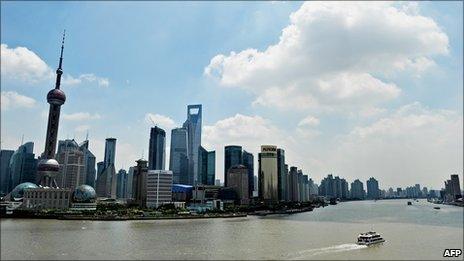Megacities: China's urban challenge
- Published

To write about urbanisation in China is to traffic in superlatives.
Three decades of sustained economic growth, concentrated along the booming coast, has lured millions from the impoverished Chinese countryside. This great migration - unprecedented in human history - has put 46 Chinese cities over the one million mark since 1992, out of a national total of 102.
And this is just the start.
Currently only about 40% of China's population lives in cities, roughly that of America in 1885.
It is estimated that another 350 million Chinese will become urban by 2025, raising China's urban numbers to a cool billion.
Accommodating all these people has meant building on a scale the world has never seen before.
In the first 20 years of China's economic revolution, begun under Deng Xiaoping in the late 1970s, China built some 6.5bn sq m (70bn sq ft) of new housing - the equivalent of more than 150 million average-sized apartments.
In Shanghai there were no skyscrapers in 1980; today it has twice as many as New York. Between 1990 and 2004 developers erected 85m sq m of commercial space in the city - equivalent to 334 Empire State buildings.
Nationwide, China's construction industry employs a workforce of about 37 million.
Nearly half the world's steel and cement is devoured there, and much of the world's heavy construction equipment has relocated to the People's Republic. Tower cranes, for example, have become the ubiquitous symbol of urban China.
'Spreading pancake'
But China's urban revolution has also destroyed as much as it has built.
In its head-long rush to be rich and modern, China has deprived itself - and the world - of a priceless heritage.
Beijing, once among the world's great urban treasures, is fast becoming just another node of globalised consumerism; full of absurdly sanitised reconstitutions of its lost past, unaffordable to working people, lacerated by eight-lane highways.
Urban development in China has also displaced more people than any nation in peacetime.
In Shanghai alone, redevelopment projects in the 1990s displaced more residents than did 30 years of urban renewal in the United States.
Because China's cities are growing outward as well as upward, urbanisation has also consumed a staggering amount of rural countryside.
Between 1985 and 1995, Shanghai's footprint grew from 90 sq miles to 790.
The "spreading pancake" of urban growth in China - "tan da bing", the popular Chinese expression for sprawl - has devoured some 45,000 sq miles of productive farmland over the last 30 years, nearly half the land area of the United Kingdom.
Chinese suburban development is much more concentrated than in the US. Large detached homes owned by single-families - the American standard - are relatively rare.
The basic unit of Chinese suburbia - with its mid-rise apartment towers, community centre and shared public spaces - is half way between a Maoist "dan wei" (work unit) and a Californian gated community.
Nonetheless, such development on the urban periphery is fast making China a nation of motorists.
China's domestic car market now exceeds America's, and the largest car showrooms in the world today are not in Los Angeles or Houston but the People's Republic.
Accommodating the steady flow of new cars - Beijing and Shanghai average 1,000 new vehicle registrations a day - is a national road network on the verge of eclipsing the American interstate system as Earth's most extensive human artefact.
And with cars and highways have come all the standard spaces of suburban consumerism - drive-through restaurants and big-box shopping malls, budget chain motels, and even that vanished icon of middle America, the drive-in cinema.
Saving the world
None of this bodes well for planet Earth. How ironic that, just as the West has begun to get its environmental house in order - finally taking serious action to reduce its carbon footprint, combat global warming, and end its oil addiction - here come the millions of China, wanting the very lifestyle and material amenities that have put us on the verge of environmental collapse.
If China were to match, per capita, car ownership in the US (which is falling, incidentally), it would mean more than one billion cars.
The planet, in a word, would be fried.
And this takes no account of India, which will soon overtake China as the world's most populous nation.
Experts such as Paul Gilding have come up with a measure for our total global footprint in terms of our impact on the environment and resources. In his book The Great Disruption he concludes that our economy is operating at about 150% of capacity - in other words, the way we live will take between one-and-a-half planets to sustain.
That is not just unsustainable, it is a catastrophe.
And yet, who are we to say to China: "We've had our playful, wasteful day in the sun but you must now conserve."
Happily, we don't need to; the Chinese are saying it themselves.
Even as it sprawls, China is building more public transit than all other nations combined, and is well ahead of the US in developing sustainable building technologies and clean-energy alternatives such as solar, wind, and biomass.
According to a study by the Pew Charitable Trusts, China invested $34.6bn (£21bn) in the clean energy industry between 2005 and 2009 - nearly twice that of the US.
We may have taught China to drive, eat, and buy its way to ruin; China may yet show us how to save the world.
Thomas J Campanella is author of The Concrete Dragon: China's Urban Revolution and What It Means for the World. He is currently a Fellow in residence at the American Academy in Rome.